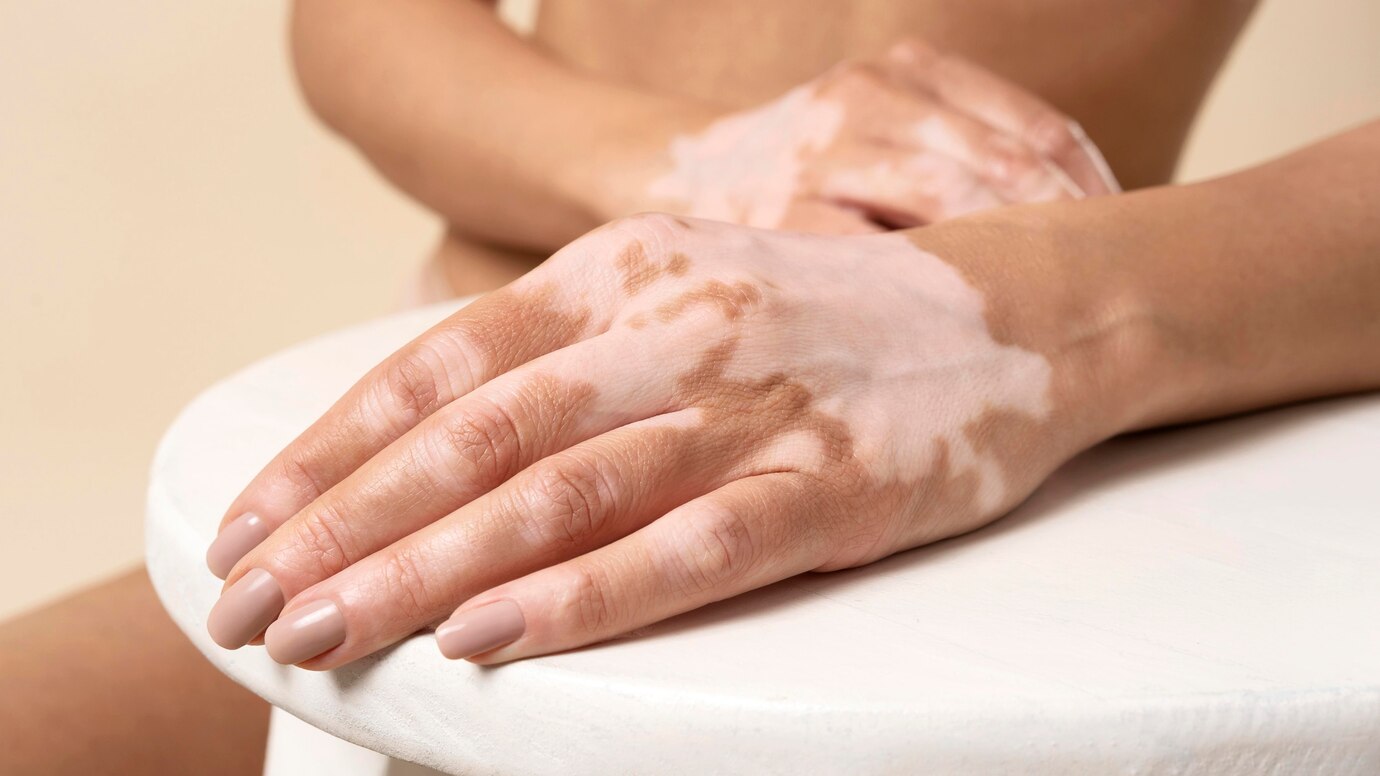Vitiligo
Our Services
Book an Appointment

Expert Vitiligo Management in Noida at Dermanation Clinic
Dermanation Clinic in Noida, under the guidance of leading dermatologist Dr. Rachna Singh, offers comprehensive and personalized care for individuals with vitiligo. Our experienced team understands the unique challenges of this condition and is dedicated to providing effective management strategies.
Vitiligo is a skin condition characterized by the loss of skin pigment, resulting in the appearance of white patches. This occurs due to the damage or destruction of melanocytes, the cells responsible for producing melanin.
Melanin is the pigment that gives color to our skin, hair, and eyes. While the exact cause of vitiligo is not fully understood, it is believed to involve a combination of genetic predisposition, autoimmune factors, and environmental influences. It's important to know that vitiligo is not contagious or life-threatening, but its impact on self-esteem and psychological well-being can be significant.
Vitiligo can manifest at any age and affect any area of the body. The extent and severity of pigment loss vary greatly among individuals. Currently, there is no definitive cure for vitiligo; however, various treatment options are available, including topical corticosteroids, phototherapy, and specialized cosmetic camouflage, which can help manage the condition and improve the skin's appearance.
Discover effective approaches for managing vitiligo in Noida at Dermanation Clinic. Dr. Rachna Singh and her team are committed to enhancing your skin health and working towards the restoration of natural skin tone in a supportive and professional environment.
Personalized Vitiligo Treatment in Noida – Dermanation Clinic
If you are seeking expert care for vitiligo in Noida, Dermanation Clinic, led by Dr. Rachna Singh, offers a range of treatment options. Vitiligo, a condition marked by pigment loss and white patches on the skin, requires a tailored approach.
At Dermanation Clinic, we prioritize a personalized treatment strategy for vitiligo, taking into account factors such as the extent of the depigmentation, your individual medical history, and your personal preferences. Common treatments that may be recommended include:
- Topical Corticosteroids: Prescription-strength creams or ointments containing corticosteroids can help reduce inflammation and potentially promote repigmentation in some cases.
- Phototherapy (PUVA or Narrowband UVB): Controlled exposure to specific wavelengths of ultraviolet (UV) light, sometimes combined with psoralen (PUVA), can stimulate melanocytes to produce pigment in the affected areas.
- Topical Calcineurin Inhibitors: Medications like tacrolimus and pimecrolimus creams can modulate the local immune response and may help in repigmentation, particularly on the face and neck.
- Specialized Camouflage Makeup: High-coverage cosmetic products can effectively conceal vitiligo patches, providing a more even skin tone temporarily and boosting confidence.
- Excimer Laser Therapy: This targeted laser treatment delivers concentrated UV light to specific vitiligo patches, aiming to stimulate repigmentation in localized areas.
Understanding the Different Types of Vitiligo
Vitiligo is classified into different types based on the pattern and distribution of the depigmented patches. The primary classifications include:
-
Non-segmental Vitiligo (NSV):
- Generalized Vitiligo: The most prevalent type, characterized by symmetrical depigmentation appearing on both sides of the body, often affecting areas like the face, hands, and limbs.
- Universal Vitiligo: A less common form where pigment loss progresses to involve almost the entire skin surface.
-
Segmental Vitiligo (SV):
- This type involves depigmentation in one or more contiguous areas on one side of the body. It often has a rapid onset and may stabilize after a period.
- Mixed Vitiligo:
- Some individuals may present with features of both non-segmental and segmental vitiligo.
- Focal Vitiligo:
- Characterized by a few isolated white patches in a localized area.
- Mucosal Vitiligo:
- Involves depigmentation of the mucous membranes, such as the lips and inside the mouth.
Recognizing the Signs and Symptoms of Vitiligo
The signs and symptoms of vitiligo can vary, but common indicators include:
- Appearance of White Patches: The most noticeable sign is the development of depigmented or white patches on the skin.
- Symmetrical Patterning: Often, vitiligo patches appear symmetrically on corresponding areas of both sides of the body.
- Premature Hair Whitening: Individuals with vitiligo may experience premature graying or whitening of scalp hair, eyebrows, eyelashes, or other body hair.
- Possible Eye Color Changes: In some instances, changes in the color of the iris or retina may occur.
- Increased Sun Sensitivity: The depigmented skin lacks melanin's natural UV protection, making it more prone to sunburn.
- Koebner Phenomenon: New vitiligo patches may develop at sites of skin injury or trauma in some individuals.
Review Form

Dr. Rachna Singh is a Dermatologist and Cosmetologist with 16 years of experience in clinical dermatology, hydra facials, pigmentation treatments, mole & wart removal. She practices at Dermanation Clinic, Sector 75, Noida.
- Home |
- About Us |
- Treatment |
- Contact Us |
Shop no - 18A first floor, spectrum mall, Dermanation clinic, Sector 75, Noida, Uttar Pradesh 201304
Mobile No: +91 093194 54789
Email: rachansingh8@gmail.com
Website: www.dermanation.in


